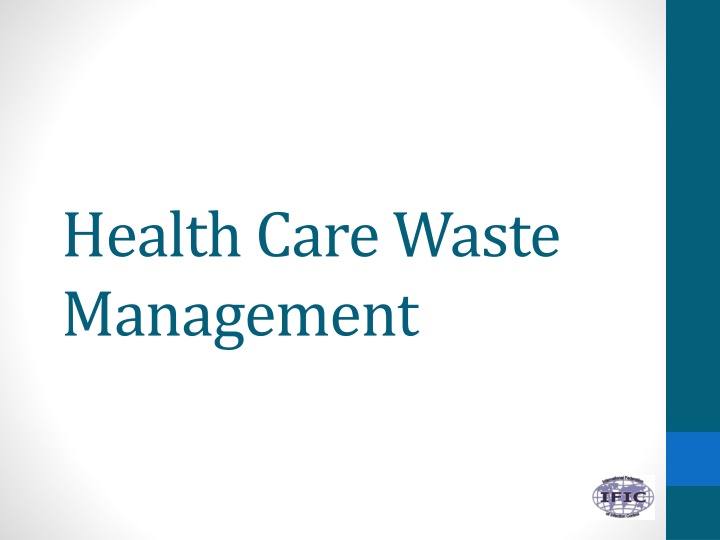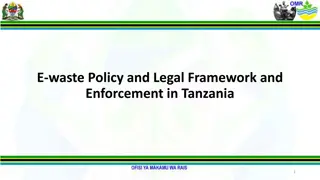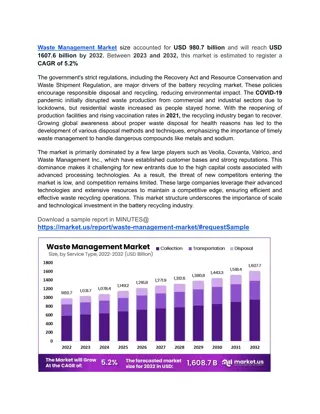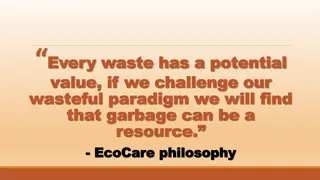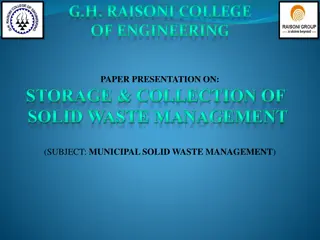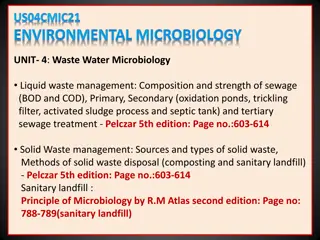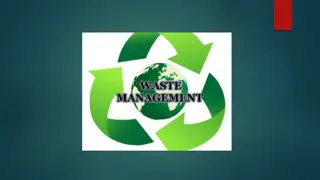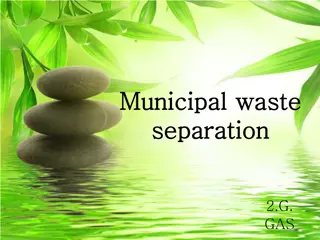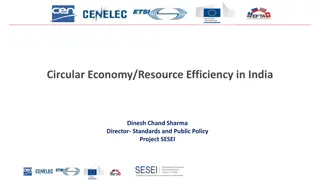Effective Health Care Waste Management Guidelines
Proper management of health care waste is crucial for creating a safer environment for staff, waste workers, and the public. This involves describing various types of waste, outlining waste sources, segregating waste appropriately, and listing treatment options. Key points include focusing on sharps handling, proper segregation, considering treatment options that reduce exposure, and emphasizing the importance of education, support, supervision, and reinforcement of practices. The content covers types of healthcare waste, definitions, learning objectives, time involved, and introduction to health care waste management.
Download Presentation

Please find below an Image/Link to download the presentation.
The content on the website is provided AS IS for your information and personal use only. It may not be sold, licensed, or shared on other websites without obtaining consent from the author.If you encounter any issues during the download, it is possible that the publisher has removed the file from their server.
You are allowed to download the files provided on this website for personal or commercial use, subject to the condition that they are used lawfully. All files are the property of their respective owners.
The content on the website is provided AS IS for your information and personal use only. It may not be sold, licensed, or shared on other websites without obtaining consent from the author.
E N D
Presentation Transcript
Health Care Waste Management
Learning Objectives December 1, 2013 1. Describe the various types of waste in health care. 2. Outline the sources that result in health- care waste. 3. Segregate the healthcare waste appropriately. 4. List the options for waste treatment. 2
Time involved December 1, 2013 40 minutes 3
Key Points Sharps most likely health care waste to cause injury and/or exposure At a minimum, a waste management program must focus on sharps handling Proper segregation using available means will reduce the risk of disease transmission and minimise the amount of waste generated A range of treatment options for waste are available Consideration should be given to those that reduce the opportunity for exposure and impact on the environment Education/training, support, supervision and regular reinforcement of practices are the keys to success December 1, 2013 4
Introduction December 1, 2013 Proper management of health care waste creates a safer environment for staff, solid waste workers, and the public Health care waste management is dictated by professional standards local laws and national legislation available resources 5
Types of Healthcare Waste December 1, 2013 Sharps waste Infectious waste Pathological waste Radioactive waste 6
Definitions - 1 Type of Waste Definition Examples December 1, 2013 Auto-disable syringes Broken glass Hypodermic, intravenous, or other needles Infusion sets Knives Pipettes Scalpels Syringes with attached needles Sharps waste Used or unused sharp items Excreta Laboratory cultures Tissues (swabs), materials, or equipment that have been in contact with infected patients Waste contaminated with blood and other body fluids Waste from isolation wards Infectious waste Waste suspected to contain pathogens 7
Definitions - 2 Type of Waste Definition Examples December 1, 2013 Pathological waste Body parts Fetuses Human tissues, organs or fluids Pathological waste Pharmaceuticals that are expired or no longer needed Cytotoxic waste containing substances with genotoxic properties, e.g., waste containing cytostatic drugs (often used in cancer therapy) Genotoxic chemicals Items contaminated by or containing pharmaceuticals Pharmaceutical waste, including cytotoxic waste Waste that does not pose a biological, chemical, radioactive, or physical hazard Non-risk general waste Non-risk general waste 8
Definitions - 3 Type of Waste Definition Examples December 1, 2013 Broken thermometers and blood- pressure gauges Disinfectants that are expired or no longer needed Film developer Laboratory reagents Pressurised containers Solvents Waste with high content of heavy metals, e.g., batteries Chemical waste Waste containing chemical substances Contaminated glassware, packages, or absorbent paper Sealed sources Unused liquids from radiotherapy departments or laboratory research Urine and excreta from patients treated or tested with unsealed radionuclides Radioactive waste Waste containing radioactive substances 9
Sources - 1 December 1, 2013 Infectious and pathological waste Chemical, pharmaceutical and cytotoxic waste Sharps General waste Hypodermic needles, intravenous set needles; broken vials and ampoules Dressings, bandages, gauze, and cotton contaminated with blood or body fluids; gloves and masks contaminated with blood or body fluids Blood and other body fluids; suction canisters; gowns, gloves, masks, gauze, and other waste contaminated with blood and body fluids; tissues, organs, fetuses, body parts Blood and body fluids; microbiological cultures and stocks; tissue; infected animal carcasses; tubes and containers contaminated with blood or body fluid Broken thermometers and blood pressure gauges; spilt medicines; spent disinfectants Packaging, food scraps, paper, flowers, empty saline bottles, non-bloody diapers; non-bloody intravenous tubing and bags Packaging, uncontaminated gowns, gloves, masks, hats and shoe covers Medical ward Needles, intravenous sets, scalpels, blades, saws Operating theatre Spent disinfectants Needles; broken glass, Petri dishes, slides and cover slips; broken pipettes Fixatives; formalin; xylene, toluene, methanol, methylene chloride, and other solvents; broken lab thermometers Packaging; paper, plastic containers Laboratory Expired drugs; spilled drugs Packaging, paper, empty containers Pharmacy Silver; fixing and developing solutions; acetic acid; glutaraldehyde Radiology Packaging, paper 10
Sources - 2 Infectious and pathological waste Chemical, pharmaceutical and cytotoxic waste Sharps General waste December 1, 2013 Bulk chemotherapeutic waste; vials, gloves and other material contaminated with cytotoxic agents; contaminated excreta and urine Disinfectants (glutaraldehyde, phenols, etc.), cleaners, spilled mercury, pesticides Chemotherapy Needles and syringes Packaging, paper Packaging, flowers, newspapers, magazines, cardboard, plastic and glass containers, yard waste Packaging, construction or demolition waste, wood, metal Environmental Services Broken glass Cleaning solvents, oils, lubricants, thinners, asbestos, broken mercury devices, batteries Engineering Food scraps; plastic, metal and glass containers; packaging Packaging, office paper, newspapers, magazines, uncontaminated gloves and masks Food services Needles and syringes, broken ampoules and vials Cotton, gauze, dressing, gloves, masks and other materials contaminated with blood or other body fluids Cotton, gauze, gloves, masks and other materials contaminated with blood Broken thermometers and blood pressure gauges; expired drugs; spent disinfectants Physicians offices Needles and syringes, broken ampoules Dental amalgam; spent disinfectants Packaging, office paper, newspapers, magazines, uncontaminated gloves and masks Domestic waste Dental offices 11 Lancets and insulin injection needles Bandages and other material contaminated with blood or other body fluids Home health care Broken thermometers
Collection December 1, 2013 Collect in containers that reduce the risk of exposure to users Label with the international biohazard symbol Do not overfill 12
Collection December 1, 2013 Segregate from regular garbage Place in special collection containers at the point of generation keep separate from other waste Place labelled containers in areas where the specific waste is generated along with containers for general garbage Non-infectious and non-hazardous waste should be disposed of with regular garbage, recycled, or composted, as appropriate 13
Collection Containers - 1 December 1, 2013 Type of Waste Specifications for Container or Bag Examples Container should be puncture- resistant, leak-proof on the sides and bottom, and durable. Container should have the biohazard label. Container should be closable for transport. Empty bleach bottle with a biohazard label. Thick, rigid, puncture-resistant cardboard box with a biohazard label. Rigid plastic container with a biohazard label. Sharps Plastic bag that is leak-proof; designed to prevent ripping, tearing, or bursting under normal use. The plastic bag should be placed inside a rigid container. Rigid container should be leak- proof, durable, labeled with the biohazard symbol, and red or yellow in colour. Red or yellow plastic bags should be used. When coloured bags are not available, plastic bag with the biohazard label can be placed in a red or yellow-painted garbage can or dust bin. Non-sharps biomedical solid and semi- liquid waste 14
Collection Containers - 2 December 1, 2013 Type of Waste Specifications for Container or Bag Examples Container should be leak-proof and durable. Container should be marked with the biohazard label if it will be used to transport waste. Container should be designed to be transported without spillage. Bottles, vials, plastic containers, canisters, pails marked with biohazard labels. Non-sharps biomedical liquid waste 15
In-House Transport December 1, 2013 Waste transporters should wear gloves Cart for transporting healthcare waste within a facility should be fully enclosed Health care waste carts should not be used for regular garbage 16
Storage Minimise the impact of odours or putrescent waste Do not store for more than 3 days Putrescent waste should be transported to the landfill immediately and buried in special trenches Be accessible to authorised employees only and lockable to prevent unauthorised access Be protected from animals and not provide a breeding place or food source for insects and rodents Kept clean and free at all times of any loose debris and standing water Disinfect weekly and whenever a spill occurs December 1, 2013 17
Treatment and Off-Site Transport December 1, 2013 The World Health Organization does not recommend use of campfire-style open-pit burning, burning in a cement firebox, burning in drums, or open-burn cement-block incinerators, which should be discontinued 18
Incineration December 1, 2013 Small in-house incinerators, the local crematorium, and newer large-scale medical waste incinerators need to meet strict air pollution control requirements Where possible, should be replaced by cleaner, state-of-the-art non-burn treatment technologies 19
Waste Treatment and Disposal Options - 1 December 1, 2013 TYPE OF WASTE Methods Notes All infectious wastes Except cultures and anatomical parts Packaging, transport, and treatment by incineration or non-burn technology. When no technology is available, burial in special landfill trenches This method should be used by large facilities (e.g., hospitals). All infectious wastes Except cultures and anatomical parts Small on-site burial pits This method could be used in health centres away from coastal areas and local wells, in areas that do not flood, and where the water table is at least 1.5 metres deeper than the bottom of the pit. 20
Waste Treatment and Disposal Options - 2 December 1, 2013 TYPE OF WASTE Methods Notes Small on-site autoclaves or pressure cookers. Interment at burial grounds or cemeteries. Preferably in the laboratory. This is the basic method for body parts. Cultures Anatomical parts Anatomical parts Cremation. ? use a local crematorium. Placenta waste And small- tissue waste Small on-site burial pits or interment at burial grounds or cemeteries. These are acceptable methods. Placenta waste And small- tissue waste Composting method. This is an acceptable method. 21
Waste Treatment and Disposal Options - 3 December 1, 2013 TYPE OF WASTE Free-flowing blood and body fluids Methods Notes Sanitary sewer. When sanitary sewers are not available, known infectious blood and body fluids should be decontaminated with the addition of disinfectant such as sodium hypochlorite. This method applies to all health facilities with sanitary sewers. 22
Transport Waste contained in sealed plastic bags and/or sharps containers Place in hard corrugated cardboard boxes or reusable plastic bins for transport every few days (sooner for putrescent waste) or whenever sufficient waste has accumulated Containers have biohazard labels or are colour coded e.g., red or yellow or as dictated by local legislation December 1, 2013 23
Management December 1, 2013 Waste management should be incorporated into policies, procedures, and programmes to minimise the risk of spreading infection in and from the health care facility, thereby protecting patients, healthcare workers, and the public 24
Training December 1, 2013 Initial training emphasise safe healthcare waste management practices Practical training provided to all those involved in handling, packaging, transporting, and disposing of health care waste. 25
References Healthcare waste, World Health Organization http://www.who.int/water_sanitation_health/healthcare _waste/en/ MedWaste Treatment Minimizing Harm, Maximizing Health 2003. Health Care without Harm. http://www.bvsde.paho.org/bvsacd/cd43/mer.pdf UN Global Environmental Fund (GEF) Global Healthcare Waste Project. http://www.gefmedwaste.org World Health Organization: Safe Injection Global Network. http://www.who.int/medical_devices/collaborations/net work/en/ December 1, 2013 26
Quiz 1. The majority of hazardous healthcare waste includes the following types: a. Sharps and Infectious b. Infectious and Pathological c. Chemical and Infectious d. Infectious and Pharmaceutical Waste containers must: a. Have a biohazard label b. Not be overfilled c. Not pose a risk d. All of the above The type of treatment for healthcare waste depends primarily on: a. Economic resources b. Transportation options c. Available landfills d. All of the above December 1, 2013 2. 3. 27
International Federation of Infection Control IFIC s mission is to facilitate international networking in order to improve the prevention and control of healthcare associated infections worldwide. It is an umbrella organisation of societies and associations of healthcare professionals in infection control and related fields across the globe . The goal of IFIC is to minimise the risk of infection within healthcare settings through development of a network of infection control organisations for communication, consensus building, education and sharing expertise. For more information go to http://theific.org/ December 1, 2013 28
